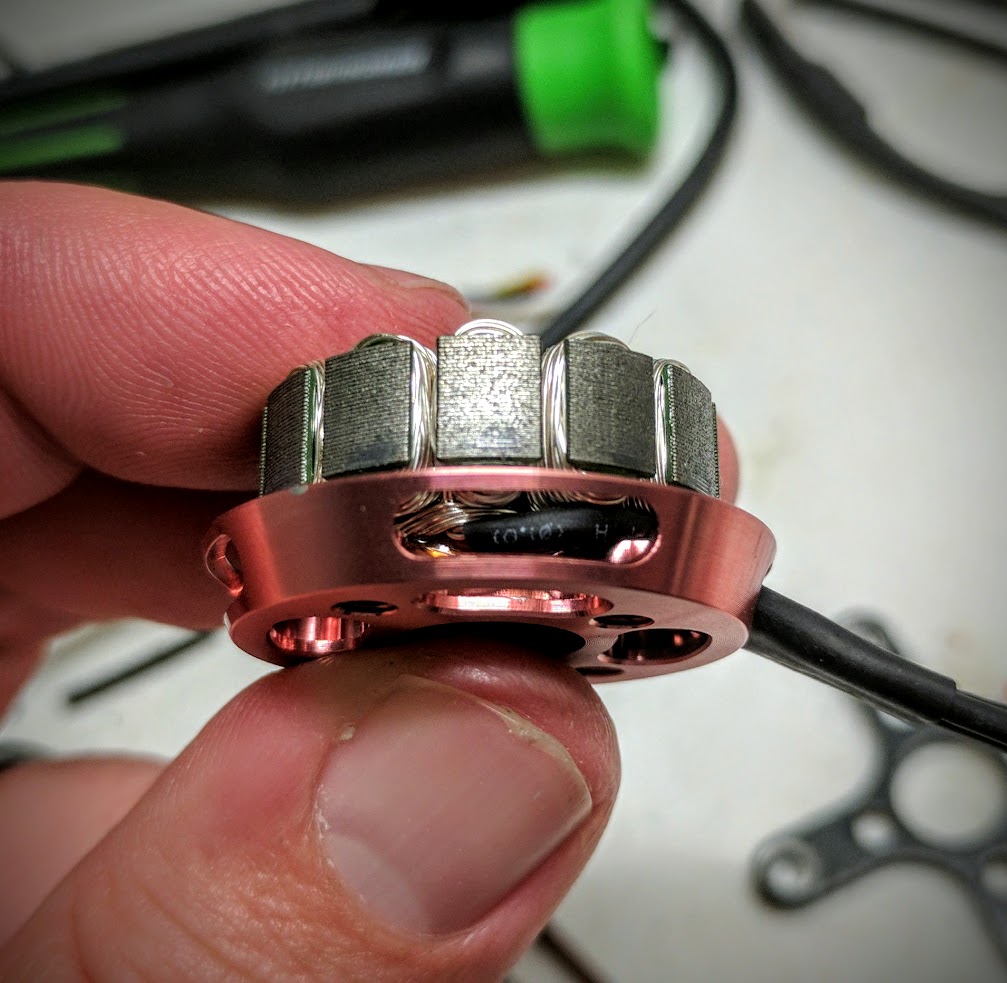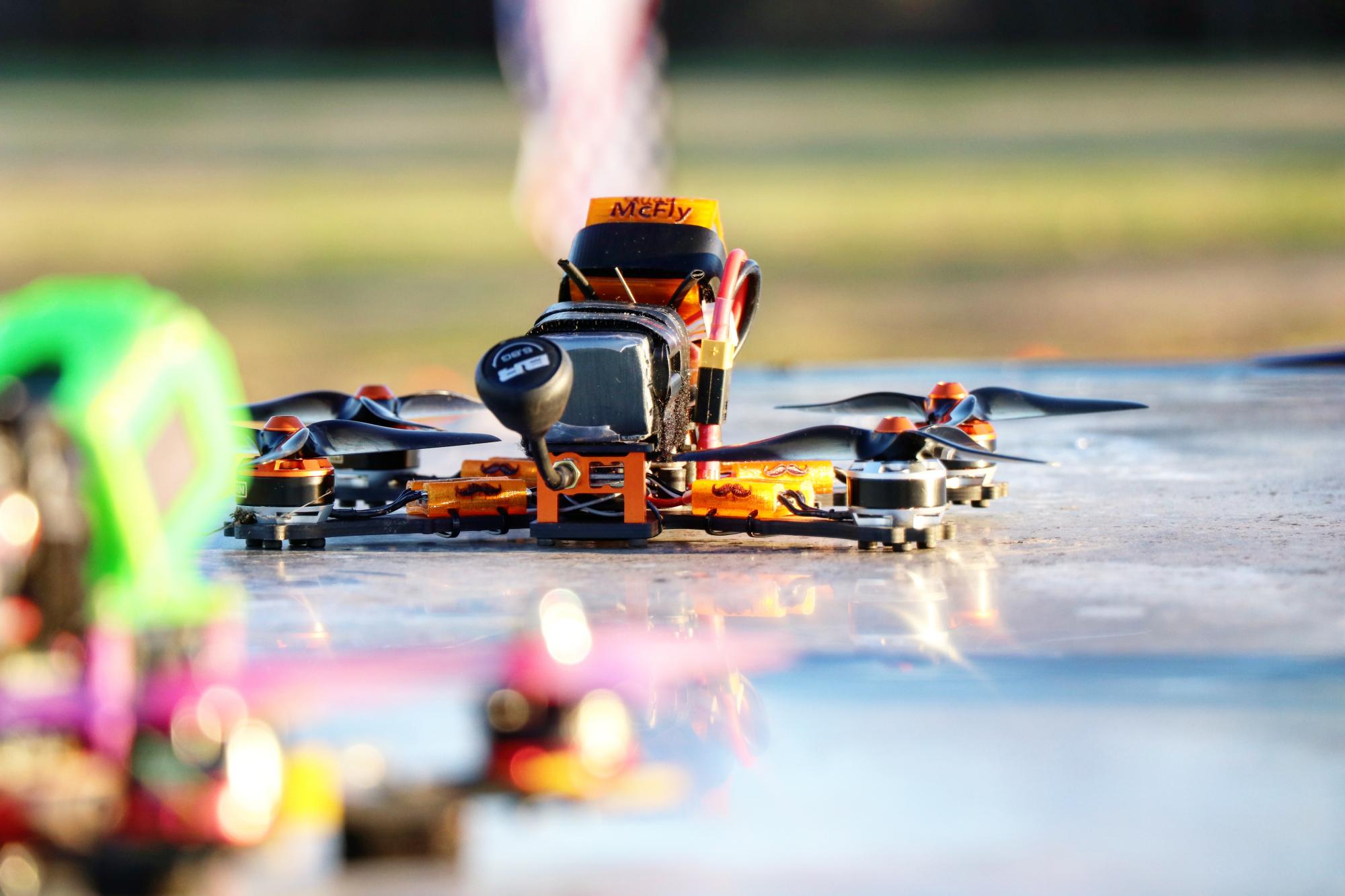Brushless Motors and Torque

When it comes to brushless motors there are a number of constants inherent to a given motor that define how that motor behaves, both electrically and mechanically. Let’s take a closer look at two of these constants: the velocity constant (Kv) and the torque constant (Kt.)
Velocity Constant (Kv)
Probably the most familiar constant is the Velocity Constant or Kv. Technically Kv is the back voltage or Back Electro-Motive Force (BEMF) that is generated in the non-active coils by the motor when it is spun at a given RPMs. The constant is called the velocity constant, hence the notation K ( scientific notation for constant) and v for velocity. At a given velocity it generates a given voltage on the inactive phases. You can quite easily drive a motor at a known RPM with an external drive like a drill press, measure the RMS voltage across two of the phases and run it through a formula to get the velocity constant. The no-load RPMs of a motor, or the steady state RPMs at full voltage with no propeller attached, are a bi-product of the Kv that are commonly used as a reference point. The back voltage is the true measure if Kv, but the velocity constant can be fairly accurately simplified as the number of rotations per minute a motor will spin under no load per volt of applied electricity. Remember that as we’ll come back to it later.
The Kv of a motor is constrained by both the magnetic field strength at the stators and the number of turns on the windings. The air gap and magnet strength in turn constrains the magnetic field strength at the stator and the windings are tuned to match that field strength to achieve a specific Kv. The higher the field strength the lower the Kv with an equivalent number of turns, so as magnetic field strength increases the number of turns on the windings must be decreased to raise the Kv back to the initial value.
The number of turns used to achieve a specific Kv also impacts the internal resistance of the windings, which plays a role in a number of other performance related aspects. The diameter of the wire, the length of the wire, and the quality of the copper or any other materials used to augment it (like silver coated wire for instance) all impact the functional resistance of the coil which in turn impacts the voltage drop across the coils.
The rise time, or the time it takes for the coils to reach the current and voltage steady state, is impacted by the total circuit resistance and the inductance of the coil. The inductance changes based on the number of turns. The higher the inductance, the longer it takes to reach a full charge, and the lower the inductance the faster it will charge. The more turns that are used in an inductor, the higher the inductance, and the fewer turns, the lower the inductance. In our case this is inversely proportional to the velocity constant (Kv). As the current begins flowing through the coil, it creates an equal BEMF reaction in the inductor which resists rapid changes in current flow. This time factor interacting with the back flow of current in the non-active phases is what defines the actual RPMs the motor will hit.
The peak measured BEMF level in this situation is always a percentage of the total supply voltage. At zero RPMs the back EMF is 0v, as the speed of the motor increases, the back EMF gets closer and closer to the forward supply voltage. Since torque is a function of current in a brushless motor, and current is equal to the voltage drop in the circuit divided by the circuit resistance, when the back EMF is equal to the forward applied voltage minus the circuit losses the functional torque of the motor will reach a point where it runs out of the torque required to accelerate the bell and RPMs can't rise further. This is also why loaded RPMs are less than the unloaded value. The motor runs into the torque limit sooner because the required torque to spin the prop is higher than the required torque to spin the bell alone.
The stronger the magnetic field at the stator, the stronger the field created in the coils and the higher the BEMF level. This is why going to a stronger magnetic field (stronger/thicker magnets, tighter air-gap, etc) lowers the functional Kv of the motor even with the same number of turns on the coil. You can actually take different bells from different motors and put them on the same windings to tell which magnets and air-gap are stronger and tighter. The lower the Kv reads, the stronger the field at the stator.
Torque Constant (Kt)
So let's talk a bit about one of the other important constants, the torque constant, or Kt. One of the biggest myths that has been floating around since the beginning of RC use of brushless motors is related to the relationship between Kv and torque. Let’s set the record straight, a change in Kv doesn't necessarily predict a consistent change torque. Kv only changes the current it takes to produce the torque, or inversely, how much torque is produced by certain amount of current. The ability of a motor to actually produce torque is a factor of things like magnet strength, air-gap, cross-sectional area of the windings, and stator size. What Kv does change is Kt.
The torque constant (Kt) describes how much current the motor will consume to produce a certain amount of torque. As the RPMs increase the current rises dramatically primarily due to the non-linear relationship between energy and RPMs. Eventually the torque limit defined by the stators, magnets, and air-gap will be reached and the RPMs won’t be able to continue, but until that point the current will continue to rise at an exponential rate.
Torque itself is simply a definition of how much rotational force can be applied, which does not have a time component or a current component inherently. However, in terms of its relationship with a brushless motor torque can be calculated as mechanical power = torque * angular velocity. To calculate angular velocity we need to convert RPMs to radians per second, so multiply RPMs by (2*pi)/60 or 0.1047.
Looking at the formulas:
RPMs = Kv*V
P = V*I
We can make substitutions in the original formula:
V*I = T * (Kv*V*0.1047)
(V*I) / (Kv*V*0.1047) = T
T = I/(0.1047*Kv)
We can arrive at the same spot by using the formulas for kT.
Kt = 1/(0.1047*Kv)
Kt = T/I
So setting these formulas equal to each other creates:
T/I = 1/(0.1047*Kv)
T = I/(0.1047*Kv)
A cursory look at this formula might make one assume that torque and kV have an inverse relationship, but that doesn’t account for current. As Kv increases the torque constant changes, which means current increases as well. Assuming current and Kv increase proportionally, that means torque stays relatively constant.
Obviously this is based on an ideal theoretical model, and in the real world we have friction, heat, and other efficiency losses that make it harder to maintain torque the higher we go in Kv. What this boils down to is that a motor of a given Kv will attempt to generate the same amount of torque per amp of current regardless of other physical properties. This also explains why larger stator motors of equivalent Kv end up drawing much more current than their smaller stator counterparts. The larger motors inherently have more torque, and since the torque per amp of current is constant for a constant Kv, that motor will draw more current when it delivers the increased torque.
In motors with weaker magnets and larger air-gaps there was a much larger disparity between Kv and torque due to the inherently low torque capacity of the designs themselves. The lower torque limits were more readily apparent as Kv increased, because they simply couldn’t push the props hard enough to establish the current required to deliver torque at higher Kv. At lower Kv the lower torque was not as much of a problem due to the lower RPM target, but if you look at the response times and load capacity even at the lower kv the lack of torque is readily apparent.
On the very high torque motors that are the core of the mini-quad world right now, the minimal torque change is much more readily apparent. It is also important to note that on high torque motors the change in Kt doesn't necessarily impact efficiency at equivalent output in a practical way, it just means that there is a lot higher current spikes during rapid changes in RPMs, and sustained increases at the top end of the throttle as the RPMs exceed the RPMs of the lower Kv motor. At equivalent constant RPMs, the difference in current draw is fairly insignificant. If you were to limit a high Kv motor to similar RPMs though you would see very little difference in overall efficiency, but you would get some small gains in the rate of RPM change due to the higher Kv.
Conclusions
The end results of all of this discussion is that we are limited primarily by the current delivery capacity of our batteries on high torque motors. Yes we can probably push the heavy 5" props and even 6" props on high torque high Kv motors, but the current demands will very quickly exceed the capacity of our batteries to deliver them. High Kv motors will often have faster response times and more power than their lower kV counterparts, but they will dramatically change both the throttle curve and the power requirements. That being said, often a low kV motor on a heavy prop and a high Kv motor on a lighter prop will have very similar power requirements.
High kV benefits more from a lighter weight build where it can make use of the extra RPMs at the top of the throttle, where mid Kv gains ground on heavier quads where the motors have to do more work low in the throttle to get the quad moving and where the high Kv motors can't unwind enough to take advantage. For instance on a heavy rig, the difference felt in the air between a high Kv motor on a lighter loaded prop and a mid kV motor on a heavier loaded prop might be fairly minimal, where the same two motors and props on a light rig may feel dramatically different in speed and handling. The high Kv motor may be able to push the heavier props and see some gains, but they will be dramatically limited by the ability of the battery to deliver the required current.









































